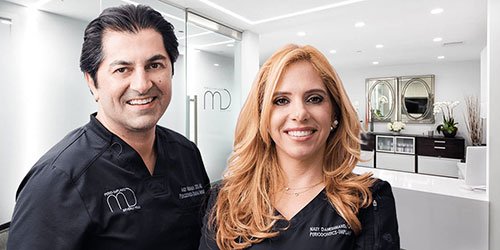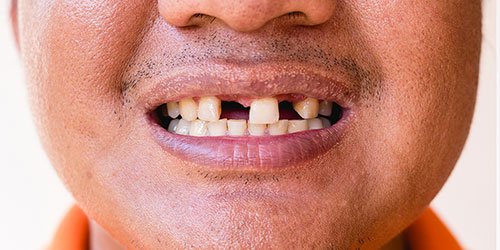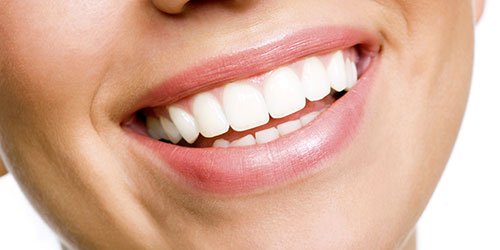What are ceramic zirconia implants?

A zirconia dental implant (also called a ceramic dental implant) is an artificial tooth made from zirconium dioxide (ZrO2), a crystalline form of zirconium that has been converted from metal to ceramic. Zirconia is particularly suited for dental material because it has similar properties to titanium, its neighbor on the Periodic Chart (remember this from 8th-grade science class?), but without the downsides of metal being placed into your body. Zirconia implants are commonly known as ceramic implants.
Unlike dentures which may slide and shift in your mouth and require messy adhesive, dental implants are permanent fixtures that resemble natural teeth.
What are the benefits of ceramic implants include?
- A translucent white color. When ceramic teeth are prepared and placed by the most experienced implant periodontists, it’s virtually impossible to tell they’re not natural teeth.
- Toughness and resistance to wear. Zirconia is five times stronger than porcelain and is difficult to crack.
- A high degree of hardness. Important for the daily wear and tear of chewing food.
- Oxidation resistance. Meaning it doesn’t break down in your mouth and release metal particles into your body.
- Completely non-metal. Ceramic implants do not require a metal stem inserted into your jawbone.
- Stain-resistant. Ceramic resists staining better than acrylic or composite ceramic crowns.

Zirconia dental implants vs. titanium dental implants
For many years, titanium was the gold standard for tooth replacement. This was due to its tensile strength and high success rate with assimilation into bone tissue (known as osseointegration) and good bone-to-implant contact. However, there are some problems with titanium implants.
The first problem: titanium implants do not look like natural teeth. They are not bad, but they do not look natural.
Another issue: as titanium implants age, problems begin to arise. These include corrosion resulting from long-term exposure of the titanium to saliva, fluoride, and other metals in tooth fillings. This, in turn, leads to metal debris being scattered in the soft tissue surrounding the implants. An inflammatory response known as peri-implantitis follows, causing the bone to resorb and the implants to loosen.
Furthermore, the two-component design of titanium implants created an opportunity for moisture and bacteria to get between the stem and the abutment post.
To address these health and aesthetic concerns, a one-piece ceramic bio-material adaptable for grafting onto bone was introduced in 2004. However, two-piece zirconia implants can be beneficial when a missing tooth requires an angled implant.
What properties make ceramic ideal for dental implants?
Due to low infection and rejection rates, ceramics were first introduced for hip replacements. Plus, no there’s no metal corrosion or debris to cause inflammatory soft tissue responses, and ceramics have sufficient compression strength to endure considerable load.

Aesthetically, ceramic zirconia dental implants match natural teeth exceptionally well. Zirconia implants are ideal for replacing teeth in the anterior area of the mouth, where they’re more visible. Please look at our before and after picture galleries for ceramic implants, and you will be hard-pressed to pick which teeth are genuine and which are ceramic implants. They are that real-looking.
Also, because ceramics don’t conduct heat as well as metals do, there is very little trouble with temperature sensitivity. What’s more, ceramic is relatively smooth, which makes it difficult for bacteria to thrive. These properties have made ceramic a popular material for implants in recent years.
As leaders in implantology, MD Periodontics was one of the first implant dental centers in the United States to be selected by CeraRoot, the pioneers in ceramic implant systems, when they received FDA approval in 2011. CeraRoot’s long track record of success dates to 2004 when they first introduced ceramic implants in Europe.
What are the advantages of Ceramic Dental Implants over Titanium Implants?
While ceramics have many advantages over titanium as dental implants, we have chosen eight to focus on.
- Ceramic Implants are more biocompatible with the human body
Ceramic implants are made from zirconia – a ceramic material that is readily integrated into bone tissue. Their biocompatibility avoids rejection, inflammation, or implant failure that can come with metal implants. They are also allergy-free! - Metal-free means hypoallergenic
Clinical studies have shown ceramic implants do not provoke allergic reactions with delicate gum tissue unlike titanium and other metals. Therefore, they are a good biomaterial choice for anyone with metal allergies.
If you or your dentist suspect you have metal allergies, a Melisa test can detect a nickel or titanium allergy. If this is the case, a metal-free solution is the best option for you. - Better Appearance
A fairly common problem with titanium dental implants is that the metal rim of the implant can become visible when patients have thin or receding gums. This creates an unsightly thin grey line where the tooth meets the gum. Because zirconia is white, it looks like a natural tooth, so receding gums don’t pose an esthetic problem. - More corrosion-resistant
Over time, titanium has been shown to have corrosion problems arising from chemical reactions between saliva, fluoride, and the metals in tooth fillings. As the titanium broke down, metal debris would scatter in the soft tissue surrounding the implant that would, in turn, cause an inflammatory response. The body then attacks the implant, causing bone loss and implant loosening.
On the other hand, ceramic is biologically inert, meaning that it doesn’t react with materials that can cause it to break down. - Less Bacteria Friendly
Because zirconia does not conduct an electrical charge, it creates a less friendly environment for bacteria to grow. This lack of conductivity can be an asset for keeping gums healthy and breath fresh. - Holistic Dentistry Compliant
An important benefit of zirconia implants is that they’re electrically inert for those who follow holistic dentistry practices. Therefore, the implants don’t obstruct energy flow through the body’s meridians. - A simpler and more hygienic design
Titanium implants contain two pieces: a screw-like stem drilled into the jaw and grows into the jawbone and a post (called an abutment) that screws on top of the stem just below the gumline. The artificial tooth is then fitted onto the abutment.
In two-part implant systems, chewing causes micro-motion between the two parts of the implant below the gumline. This creates a micro-gap that is a moist, bacteria-friendly environment. Bacteria growth can lead to local inflammation at the bone level and cause loosening of the implant.
The one-piece design of a ceramic implant sidesteps this problem. The stem and implant abutment are incorporated into one seamless component, so there’s nowhere for bacteria to hide. Moreover, because the zirconia abutment sits above the gum line, it’s accessible to the toothbrush and, therefore, much easier to keep clean. - A shorter and more comfortable implant procedure
Ceramic implants are designed to be placed into the hole created right after a tooth is extracted. A two-part implant requires two dental procedures: one to insert the stem and sew the gum over it, and a second surgery weeks later to cut open the healed gum, expose the branch, and attach the abutment post.
With CeraRoot, there’s no need for two surgeries! That means less anesthesia, less discomfort, and one less dentist visit for our implant patients.
What are the disadvantages of Ceramic Dental Implants versus Titanium Implants?
As with anything in life, nothing is perfect, and that includes beautiful, natural-looking ceramic implants.

- Titanium has been around for several decades, so its long-term durability is far better known. Even though ceramic implants have enjoyed an excellent track record in implant dentistry over the last 15 years with perfect bone integration, low complications, and excellent implant survival rates. But, we still lack very long-term data on ceramics regarding durability.
- It takes a very experienced implant periodontist to fit ceramic teeth correctly. “Getting it right” when it comes to one-piece ceramic implant placement means being close to perfect. There is very little room for error, so unless you are in the hands of a real expert in the field, your chances of having implant failure are increased.
- To be a good candidate for a one-piece implant, you must have healthy bone tissue. The bone must be healthy where the ceramic implant is placed. This requirement can be mitigated somewhat by using a two-piece ceramic implant.
- Having exceptional implant treatment outcomes requires a periodontist with a high degree of expertise in ceramics who can assess your bone quality and fit you correctly with the most appropriate type of implant. Your periodontist can also explore the possibility of a bone graft.
Am I a good candidate for a ceramic implant?
Natural-looking ceramic implants offer many advantages; however, they may not be right for everyone. The best candidates will:
- Practice good oral hygiene and be in general good health
- Have no existing gum disease. Our dental care experts can address periodontal disease before evaluating you for implants if necessary.
- Be a non-smoker
- Not seriously grind teeth (have bruxism). This condition can disqualify you because the flexural strength of the ceramic may not withstand extremely prolonged high compressive forces over its lifetime.
- Have sufficient bone density to demonstrate good bone healing potential. If you do not have enough bone available in exactly the right place, you can still qualify for natural-looking ceramic teeth with a two-piece ceramic implant system or after a bone graft. Once we examine you, we can discuss your options and the plusses and minuses of each available option.
It takes a very experienced implant periodontist to fit ceramic teeth correctly.
Titanium vs. Ceramic: Which dental implant is right for me?
Choosing which dental implant material is best for you requires a detailed examination with X-rays and an in-depth conversation with experienced implant specialists (such as the nationally recognized ones at MD Periodontics).
Our doctors will walk you through the various types of dental implants, discuss their advantages and disadvantages, and answer your questions in a patient and professional manner.
Why trust MD Periodontics to create your perfect and natural-looking dental implants?

- Experience
Board-certified Drs. Moshrefi and Daneshmand have almost 40 years of combined experience in periodontics, dental implant surgery, and restorative dentistry. They have served as faculty at USC School of Dentistry and offer the latest technology in implant dentistry available in the US. - Personal Attention
At MD Periodontics, we know that every patient is different. That is why our experienced implant specialists take the time to understand your dental needs fully.
After performing a comprehensive examination that includes digital X-rays and 3D imaging to capture the most precise imaging available, our implant specialists will carefully explain available treatment options for creating a not only functional but extraordinarily natural-looking mouth. - Affordable Dental Implants
To make the cost of dental implants accessible, we offer financing options to facilitate payments. Because when it comes to preserving your oral health, some interventions can’t be delayed.
To schedule a consultation, click here or call us at (310) 859-9449. Your smile will thank you!
Where to find zirconia implants near me?
We are conveniently located to patients throughout Southern California and the Los Angeles area. Our Beverly Hills office is conveniently located near West Los Angeles, Culver City, West Hollywood, Downtown Los Angeles, Marina del Rey, Pacific Palisades, Malibu, Manhattan Beach, Sherman Oaks, and Encino.
Zirconia implant FAQs
How long do zirconia implants last?
The exact lifespan of zirconia implants can vary depending on various factors such as the patient’s oral hygiene habits, overall health, and lifestyle factors such as smoking or teeth grinding. However, some studies have shown that zirconia implants can have a success rate of up to 97% after 5 years and up to 94% after 10 years.
Are zirconia dental implants safe?
Zirconia dental implants are considered safe and have been used as an alternative to traditional titanium implants for many years. Zirconia implants have a lower risk of causing metal allergies or interference with diagnostic imaging than titanium implants.
Do zirconia implants stain?
Zirconia dental implants are highly resistant to staining and discoloration, thanks to their strong and durable ceramic material. Unlike natural teeth or some dental restorations that may become discolored over time due to exposure to food and beverages, zirconia implants are not porous and do not absorb stains or discoloration.
 (310) 859-9449
(310) 859-9449 Ceramic Zirconia Implants
Ceramic Zirconia Implants
 or call us at
or call us at 















































